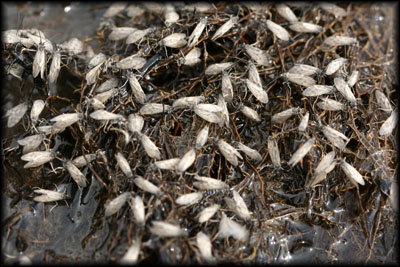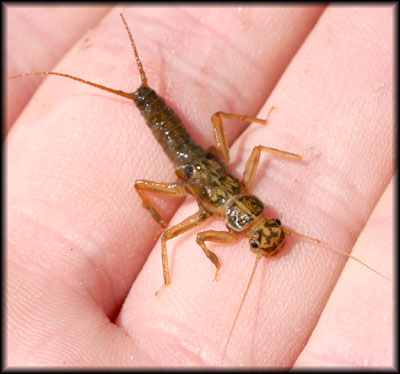
Photography || Portfolio Site || Blog || About || Contact || Home ||
Predicting the Early-Season Hatches
Published in the March/April 2009 issue of the Montana Sporting Journal
By Joshua Bergan
In exactly 41 days, 3 hours, 22 minutes and 13 seconds, a cocooned caddis pupa will squirm to the surface of your favorite river, shed its shuck and flutter away. This seemingly meaningless event symbolizes the start of the annual Motherís Day caddis hatch, one of the most anticipated events on the fly anglerís calendar.
Alas, if the hatches were that predictable, fly fishing wouldnít have near as much literature, nor would it be near as exciting.

The timing of these hatches can seem like an enigma, despite the fact that we live in a time when science can tell us darn near exactly what conditions these bugs need to hatch (water temperature, cloud level, state of the caddisí pupation, etc.).
For Motherís Day caddis (brachycentrus), they say the water temperature should be right around 54 degrees, which usually happens between April 15 and May 1 on Montanaís mountain-born waters. But this past year, like so many other years, May 1st came and passed, the water temperature hit 54 degrees for several days in a row, but aside from a few stragglers, the caddis never hatched.
Daily predictions that the hatch would explode tonight was a ritual in workplaces across the state, and fly shop marker boards had anglers on the edge of their seats.
But the good news never came.
A few brachycentrus eventually appeared, but the storm passed after a few threatening clouds. The anticlimax was enough to frustrate even the most dedicated nympher, for a true Motherís Day caddis hatch is a spectacular event to bear.
Old-timers tell tales of trout blitzes, of rising fish boiling the water from bank to bank, of zero-visibility conditions, and of going home well before sundown because their arms were jello.
Iíve personally been in Montana for four consecutive May 1sts and have yet to encounter one of these legendary sedge storms. Iíve fished the consolation Motherís Day caddis hatches on storied rivers that would be great days in October, but relative to the tales that bounce around, they lack luster.
Apparently, it takes the perfect storm of water temperature, full pupation, weather conditions and je ne c'est quoi to form the perfect storm of Motherís Day caddis.
Fortunately, thereís a hatch that precedes the brachycentrus. Itís a famous hatch that occurs on only a few rivers, and itís as reliable as a whitefish on the Yellowstone River.

It is the skwala stonefly.
Very simply, when the water temperature hits 46 degrees, the big yellow nymphs will begin their migration to the riverís edge, crawl up over the rocks and partake in their rite of passage. The best part: You can set your watch to the skwala hatch on the Bitterroot River.
The lower elevation of the Bitterroot Valley (relative to the higher elevation of the waters closer to Yellowstone Park) results in warmer water temperatures earlier in the year which is why the Bitterroot hosts one of the first skwala hatches. The hatch will commence near Missoula and it will work its way upstream as the water warms.
Skwalas are not the only adult stonefly present on the Bitterroot at this time. The lesser-known nemoura stonefly (little brown stonefly or winter stonefly) is just-as-if-not-more abundant than the skwala, and fish will rise for adults. That said, the skwalas provide a heartier meal, thus are often the preferred prey.
But the Bitterrootís skwala hatch isnít necessarily picture perfect, either. The influx of fishing pressure can make it seem a bit like being in a midge swarm surrounded by a summertime caddis hatch. Anxious anglers eager to emerge from hibernation, coupled with some seriously exciting dry-fly fishing and scads of river users make for a hectic scene. Boat parades are common, access sites overflow, stream access laws get abused, and tempers can flare (especially because of the already-heightened tensions between riverfront landowners and river users in the Bitterroot Valley due to the Mitchell Slough ordeal).
A further drawback to the skwala hatch is that skwalas are not nearly as widespread as Motherís Day caddis. There are only a few rivers in Montana that are reported to get a fishable hatch: the Big Hole, Rock Creek, the Bitterroot, the lower Clark Fork, the Blackfoot, the lower Madison, the upper Gallatin and the Smith. But make no mistake Ė the Bitterroot is the population center.
For most anglers, itís worth the trouble. Itís still a hatch of big stoneflies that will draw hungry trout ripping through the surface Ė a sure way to melt the doldrums.

Best of all, these early-season hatches offer a taste of the warmth and excitement that lies just downstream.
So hereís hoping that our beloved Mothers will be without their fisher-kids on their special day (sorry mom) this year Ė kept warm by a bouquet of roses and the thought that their offspring are drenched in a fly fishing bliss.
How to identify a skwala
There seems to be plenty of confusion about exactly what a skwala looks like. There can be a ton of different varieties of early-season stoneflies emerging that many anglers assume are skwalas, but most of these bugs donít hatch in high enough quantities to earn the troutsí attention.
Skwalas are about a size 8, their bodies are olive as are their necks, and they have brown wings. They look very similar to golden stones, but theyíre olive/brown. Their nymphs are mustard yellow with mottled wingcases. One sure way to know if youíve encountered a skwala hatch is if you see some with underdeveloped wings (about half-way down the body, instead of covering the body and then some, as is normally the case with stoneflies). These are the male skwalas. No other stonefly (at least none that flyfishers care about), male or female, has this distinct characteristic. Season is another good indicator Ė you will only find skwalas in the spring.